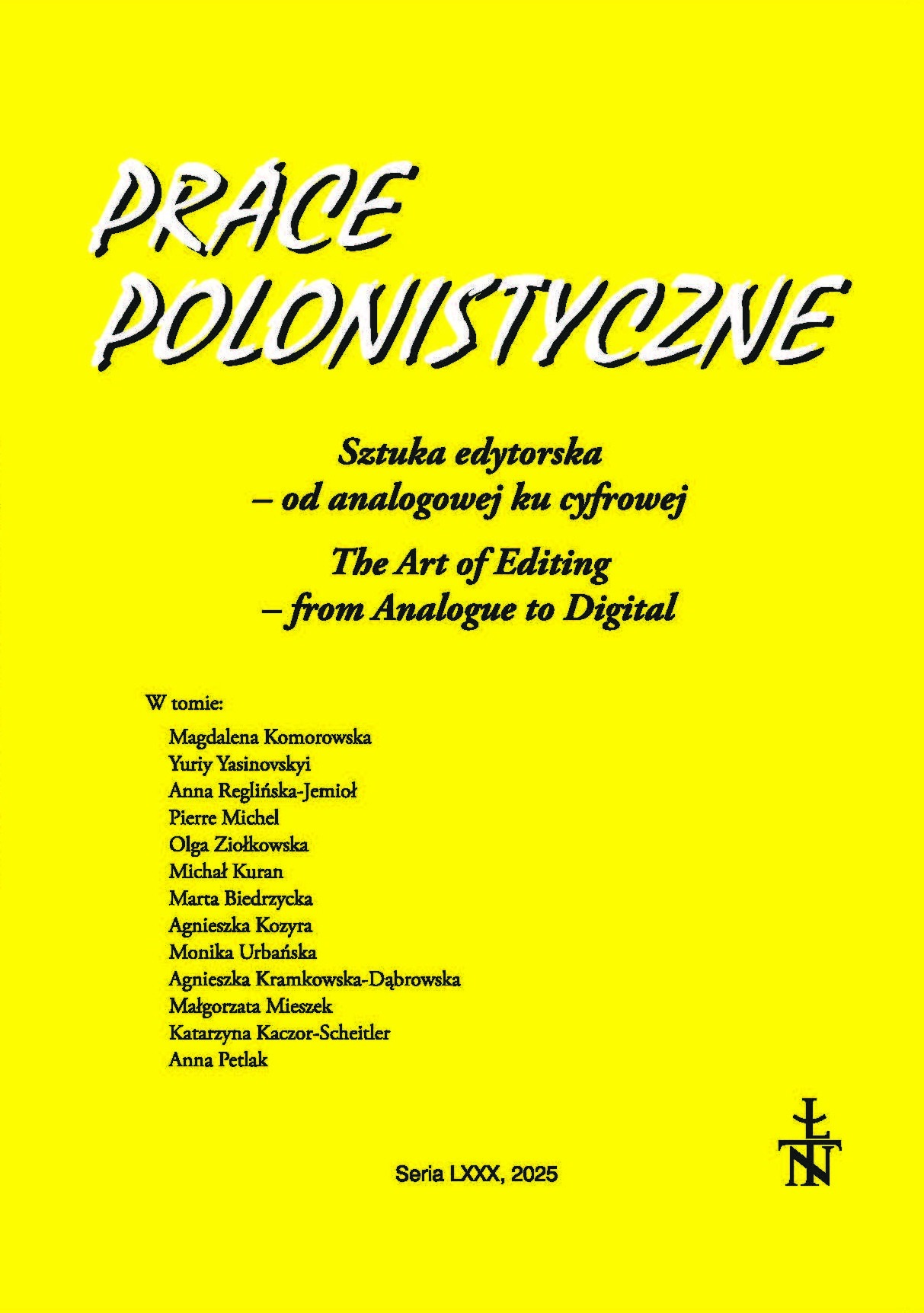DIGITAL SCHOLARLY EDITING AND THE PUBLISHING PROCESS
DOI:
https://doi.org/10.26485/PP/2025/80/1Keywords:
digital scholarly editing; editing of early modern texts; textual studiesAbstract
This article focuses on the publishing process of digital scholarly editions. Refined over the centuries, the publishing procedures for printed scholarly editions have become a wellestablished practice that is often taken for granted. Even though it may seem otherwise, their complexity rivals that of creating digital editions. However, the absence of standardized procedures, dedicated publisher support, and WYSIWYG tools designed specifically for digital scholarly editions makes the process both arduous and time-consuming. Using the example of digital editions developed at the Faculty of Polish Studies of the Jagiellonian University in Kraków, the article explores potential solutions to these challenges, both project-specific and universally applicable.
References
Aarseth Espen. 2014. Cybertekst. Spojrzenia na literaturę ergodyczną. Kraków: Korporacja Ha!Art.
Advances in Digital Scholarly Editing. Papers Presented at the DiXiT Conferences in The Hague, Cologne, and Antwerp. 2017. Red. Peter Boot, Anna Cappellotto, Wout Dillen i in. https://www.sidestone.com/books/advances-in-digital-scholarly-editing [dostęp: 5 grudnia 2023].
Barabucci Gioele, Spadini Elena, Turska Magdalena. 2017. Data vs Presentation. What is the core of a Scholarly Digital Edition? W: Advances in Digital Scholarly Editing. Papers Presented at the DiXiT Conferences in The Hague, Cologne, and Antwerp. 2017. Red. Peter Boot, Anna Cappellotto, Wout Dillen i in. https://www.sidestone.com/books/advancesin-digital-scholarly-editing [dostęp: 5 grudnia 2023].
Bem Paweł. 2017. Dynamika wariantu. Miłosz tekstologicznie. Warszawa: IBL PAN.
Bem Paweł. 2020. Tekst edytorski czy wieloautorski? Kilka uwag o heterogeniczności edytorstwa naukowego. „Pamiętnik Literacki” 2020, nr 4. S. 19–30.
Bryant John. 2020. Płynny tekst. Teoria zmienności tekstów i edytorstwa w dobie książki i ekranu. Tłum. Ł. Cybulski. Warszawa: IBL PAN.
Deegan Marilyn, Sutherland Kathryn. 2009. Transferred Illusions: Digital Technology and the Forms of Print. Farnham, England–Burlington, VT: Ashgate.
Digital Scholarly Editing: Theories and Practices, Digital Scholarly Editing: Theories and Practices. 2016. Red. M.J. Driscoll, E. Pierazzo. Cambridge: Open Book Publishers. http://books.openedition.org/obp/3381 [dostęp: 5 grudnia 2023].
Eggert Paul. 2019. The Work and the Reader in Literary Studies: Scholarly Editing and Book History, Cambridge. Cambridge University Press.
Greg W.W. 1950/1951. Rationale of Copy-Text. „Studies in Bibliography”. S. 19–36.
Jak wydawać teksty dawne. 2017. Red. Karolina Borowiec, Dorota Masłej, Tomasz Mika, Dorota Rojszczak-Robińska. Poznań: Wydawnictwo Rys.
Kruszewski Wojciech. 2021. Dzieło – horyzont działań edytorskich. „Pamiętnik Literacki”, nr 1. S. 119–129.
Manovich Lev. 2017. Baza danych. W: Triumf typografii. Red. Henk Hoeks, Ewan Lentjes. Tłum. Magdalena Komorowska. Kraków: d2d.pl. S. 192–201.
Maryl Maciej. 2009. Reprint i hipermedialność – dwa kierunki rozwoju literatury ucyfrowionej. W: Tekst w sieci 2. Red. Anna Gumkowska. Warszawa: Wydawnictwa Akademickie i Profesjonalne. S. 84–92.
Niciński Konrad. 2023. O strukturalizmie w działaniu, czyli TEI i naukowa edycja cyfrowa z perspektywy praktyki edytorskiej. „Sztuka Edycji” 2023, nr 1. S. 103–111.
Nycz Ryszard. 2017. Nowa humanistyka w Polsce: kilka bardzo subiektywnych obserwacji, koniektur, refutacji. „Teksty Drugie” 2017, nr 1. S. 18–40.
Pierazzo Elena. 2019. What future for digital scholarly editions? From Haute Couture to Prêt-à-Porter. „International Journal of Digital Humanities” 2019, nr 1. S. 209–220.
Pisarski Mariusz. 2013. Xanadu. Hipertekstowe przemiany prozy. Kraków: Korporacja Ha!art, Narodowe Centrum Kultury.
Sahle Patrick. 2016. What is a Scholarly Digital Edition. W: Digital Scholarly Editing: Theories and Practices. 2016. Red. Matthew James Driscoll, Elena Pierazzo. Cambridge: Open Book Publishers. S. 19–40. http://books.openedition.org/obp/3381 [dostęp: 5 grudnia 2023].
Vandendorpe Christian. 2008. Od papirusu do hipertekstu: esej o przemianach tekstu i lektury. Tłum. Anna Sawisz. Warszawa: Wydawnictwa Uniwersytetu Warszawskiego. S. 47–63.
Voelker Jean Ulysses. 2020. Porządek w projektowaniu. Tłum. Magdalena Komorowska. Kraków: d2d.pl.
Downloads
Published
How to Cite
Issue
Section
License
Copyright (c) 2025 Autor

This work is licensed under a Creative Commons Attribution 4.0 International License.



